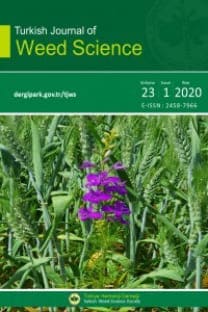TÜRKİYE’DE BUĞDAY ÜRETİM ALANLARINDA BROMUS TÜRLERİNİN İSTİLA POTANSİYELİ
Bromus, istilacı bitkiler, buğday
INVASION POTENTIAL OF BROMUS SPECIES IN WHEAT FIELDS IN TURKEY
Bromus., invasive plants, wheat,
- ISSN: 1303-6491
- Başlangıç: 1998
- Yayıncı: Türkiye Herboloji Derneği
KURAKLIK PERSICARIA PERFOLIATA'NIN TÜRKİYE'DEKİ İSTİLASINI DURDURABİLİR Mİ?
Hüseyin ÖNEN, Uğur ÇALDIRAN, Shahid FAROOQ, Cumali ÖZASLAN
SAMSUN ÇAYIR VE MERALARINDA İSTİLACI TÜRLERİN POPÜLASYON YOĞUNLUKLARININ BELİRLENMESİ
Mustafa SÜRMEN, Tamer YAVUZ, Burak SÜRMEN, H. Güray KUTBAY
İSTİLACI BİR YABANCI OT OXALIS PES-CAPRAE L. DE ÜREME VE ÇİÇEK MORFOTİPLERİ
Nemli Y., Kaya İ., Kayandan A., Er T.
AMBROSIA ARTEMISIIFOLIA’NIN KARADENİZDEKİ MEVCUT DURUMU
Hüseyin ÖNEN, Nihat AKYOL, Hikmet GÜNAL
İSTİLACI BİR BİTKİ: AMARANTHUS RETROFLEXUS L
İzzet KADIOĞLU, Bülent BAŞARAN, Yalçın KAYA
PHYSALIS ANGULATA L.’NIN GÜNEYDOĞU ANADOLU BÖLGESİNDEKİ MEVCUT DURUMU
Cumali ÖZASLAN, Bekir BÜKÜN, Selçuk ÖZCAN, Hüseyin ÖNEN
TÜRKİYE’DE SICYOS ANGULATUS ÜZERİNDEKİ KARPUZ MOSAİK VİRÜSÜ (WMV-2)’NİN İLK TESPİTİ
Fatime KORKMAZ, Kübra KARACA, Cumali ÖZASLAN, Yusuf YANAR, Hüseyin ÖNEN
İSTİLACI YABANCI OTLARDA GÖRÜLEN ÖNEMLİ BAZI VİRÜS HASTALIKLARI
KUZEY KIBRIS TÜRK CUMHURIYETI TAHIL ALANLARINDAOXALIS PESCAPRAE MÜCADELESI
Süleyman TÜRKSEVEN, Mehmet DEMİRCİ, Yıldız NEMLİ, Emine SOLYALI, Kuntay VURANA, Ali GÖKSU, Mehmet Akif ÜNSAL, Peiman MOLAEİ, Erhan HAKEL, Bahar GÖKHAN, Ayşe ERK, Emine KOCADAL, Duygu BARAKE, Ahmet ULUDAĞ
